|
|
|
|
|
|
 Name: Budapest. Actually, the name consists of two place names - Buda and
Pest. Note that the Hungarian letter 's' is pronounced 'sh'. Buda and Pest are two of the three major districts (Number 3 is Óbuda)
the town was formed of. More than 1500 years ago, the place was known as Aquincum, which was an important Roman town.
Name: Budapest. Actually, the name consists of two place names - Buda and
Pest. Note that the Hungarian letter 's' is pronounced 'sh'. Buda and Pest are two of the three major districts (Number 3 is Óbuda)
the town was formed of. More than 1500 years ago, the place was known as Aquincum, which was an important Roman town.
Location:
Budapest lies in the northern part of Central Hungary and straddles the river Danube.
West of Budapest starts hilly Transdanubia, east of the river there's the Great Plain. Geopolitically and culturally spoken, Budapest
marks the border between Western and Eastern Europe. To say it with other words - Budapest is equidistant from
Berlin and →Sofia. The second metropolis of the former Habsburg monarchy,
Vienna, is only 250 kilometres away.
Population: Around 2 million. This means, that every fifth Hungarian lives in the capital.
Orientation:
Roughly speaking, Budapest can be divided into two parts: Buda on the right (western) bank of the Danube river and
Pest on the left bank. Buda, which is rather hilly, is the older part of the city and contains the historic centre.
This again is characterized by the Várhegy (Castle Hill). On Castle Hill, important buildings such as the huge
Király Palota (Royal Palace) and the narrow, medieval castle town dominate the scene. Among other things, the
worldwide famous Halászbástya (Fishermen's Bastion) can be found there. A short funicular railway
whisks you up to the Castle Hill, but there are also small and steep lanes leading to the top of the hill.
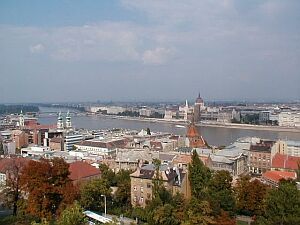
| |
A view from Buda over flat Pest
|
But Buda is not the oldest part of the capital. More than 5 kilometres north of
Castle Hill, there's a district called Óbuda. Here you will find the ruins of the old Roman settlement
Aquincum, including the remainings of an amphitheatre, an open-air museum and
the ruins of an aqueduct. Óbuda isn't really within walking distance, but it's easy to get there - just take the
commuter train direction →Szentendre and get out at Aquincum.
Amidst the Danube river, there are several flat islands. The most central one is called Margit Sziget (Margaret Island).
This island is dominated by a huge park and can be called the recreation ground for the stressed city-dwellers. The island is great for
a walk in the green, and besides it offers the ruins of two medieval monasteries. A small zoo, a rose garden, several cafés
and more can be found there as well.
Several bridges connect Buda with Pest, but definitely the most famous one is the
Széchenyi Lánchíd (Chain Bridge). When crossing the chain bridge from Buda, you will
soon get to Roosevelt tér (tér = square) on the other side. The area around this square marks
the centre of the capital. Buda might be older, but Pest is definitely more vibrant. Almost all of the administration buildings, banks,
shopping malls, bars etc concentrate in and around Pest. The city centre has got the shape of a rectangle, stretching between Nyugati pu. (West Terminal),
Keleti pu. (East Terminal), Szabadság híd (Freedom Bridge) in the south and
Margit híd (Margaret Bridge) in the north. Right in the middle of that rectangle, there's the
Deák Tér (Deak Square), where the three subway lines of Budapest meet. From there, Budapest's
most elegant and modern boulevard Andrássy utca runs north-east before it ends in front of a large park.
History:
Celtic and Avar tribes had already founded first settlements in the area, but it was the Romans that discovered the thermal
springs in and around present-day Budapest, and so they erected a town and named it Aquincum.
It soon became the most important town of Eastern Pannonia. As already mentioned above, Aquincum was located in Óbuda (Old Buda)
a few kilometres north of the modern centre. However, after the decline of the Roman Empire, Óbuda lost its importance
in favour of the development of present-day Buda.
The latter became increasingly important after the arrival of Magyar tribes during the 9th century. The devastating Mongol resp Tartar invasion during the
13th century accelerated the construction of a fortress. Ever since, most of the Hungarian kings used Buda as their residence.
During the 150 years long Ottoman occupation, more public baths using the thermal springs were built. Some of them can still be seen.
Pest on the other hand didn't start to develop before the 19th century. The first bridge spanning the Danube river and therefore
connecting Buda with Pest was built in 1849 - it was the Chain Bridge. Nowadays, seven bridges
connect Buda and Pest in the centre of town, but only three of them are more or less original. Eventually, the three towns of Buda, Pest and Óbuda
were united in the year 1873. Before that, the name 'Budapest' simply didn't exist.
At the end of the Second World War, heavy fights erupted inside the city centre. All bridges and many old buildings fell victim to
the brutal war. During the communist era, many old buildings started to crumble and some ugly concrete buildings were added to the
centre of town. Since 1989, a (re)construction boom started. Budapest is getting more and more attractive - but also shriller and kitschier.
Getting there / Urban transport:
Needless to say that Budapest is a very important transport hub. No international bus or train crosses Hungary without stopping
in Budapest. Visitors only need to be aware of the name of the train station - international train stations include the
Nyugati pu. (West Terminal), Keleti pu. (East Terminal)
and Déli pu. (South Terminal), depending on where the trains come from or go to.
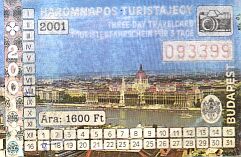
| |
3-day pass for Budapest
|
Furthermore, there are also villamos (trams), autóbusz and the
HÉV (railway) - the latter is necessary if you want to get to Aquincum for instance.
Several types of tickets confuse some visitors. Of course, the most expensive one is the single ticket (slightly less than 100 Ft.).
There are also 1-day, 3-day, 7-day and one month passes. The most convenient one is the 3-day pass, in Hungarian
Háromnapos Turistajegy, which cost 1,600 Ft in 2001. With this pass, you can use all means of
transport within the city limit without having to worry about buying new tickets everywhere.
For information on how to get to Budapest by train etc see →Travel information Hungary -
it's also possible to check train connections from and to Budapest with the help of the
German Railway Company website (English version available, prices for international trains are
not quoted ).
|
|
|
|
|
|
|
It's almost impossible to mention all interesting places in Budapest. Even a full week is not enough to get more than
a glimpse into Hungary's capital. However, Budapest is a large and hectic city, and people not being fond of large cities might
soon feel the desire to leave the town. Here are some pictures and explanations to provide a short overview:
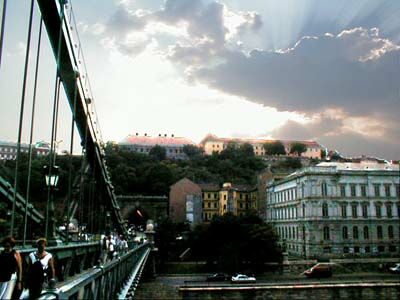
| |
View from the chain bridge direction Buda
|
The Széchenyi Láchíd, better known as the 'chain bridge', was built in 1849
shortly after the revolution, which makes it the oldest bridge in town. Crossing this bridge marks the shortest way to get to
the Castle Hill. Since the hill is quite steep, a small funicular railway helps the visitors to get to the top of the hill.
Right behind the bridge, a tunnel runs through the hill. Behind the hill, there's the Déli pu. (South train station).
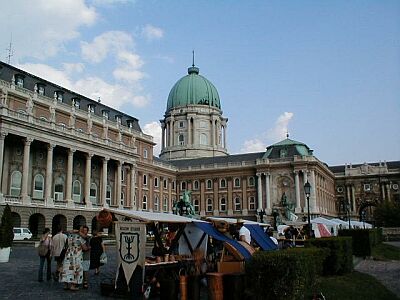
| |
The Royal Palace atop Castle Hill
|
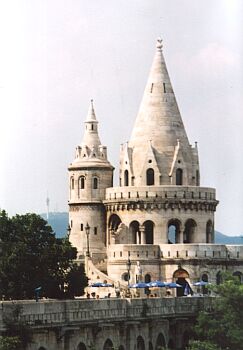
| |
Fishermen's Bastion on Castle Hill
|
The top of Castle Hill is widely occupied by the medieval and almost perfectly preserved castle town and the
large Király Palota (Royal Palace). The entire hill including the palace and the old town is
around 1.5 kilometres long and only 60 metres high. The oldest parts of the palace date back to the 13th century. Since then,
Buda played a central role in the Kingdom of Hungary. Unfortunately, intruders destroyed the fortress not just once.
Budapest also heavily suffered during the two World Wars. The castle and the area around it needed to be restored after the
war. Today, the Royal Palace is home to the National Library and three large museums, namely the
Semmelweis-Museum (Medicine), the National Gallery and the Budapest History Museum - altogether, it takes more than a full day
to see everything inside the castle.
Naturally, Castle Hill was surrounded by fortification systems. The wall includes the famous Halászbástya,
in English 'Fishermen's Bastion'. It hides behind St Matthias Church (dedicated to the author of this website!), which was
built in 1896. Fishermen's Bastion as it can be seen today is not an original - it was erected in the year 1902 and features five
small, round towers and one large tower. In medieval times, there was a fish market nearby. Additionally, fishermen on the river
Danube were observed and protected from this part of the hill.
The reason for the popularity of Fishermen's Bastion is probably not the playful architecture, but the excellent view over the
Danube, Pest and the gorgeous parliament. Admission fee to the Bastion is 200 Ft. The place is permanently overcrowded, so don't
expect a relaxing walk. As you can see on the picture to the right, Budapest's tall T.V. tower is not far.
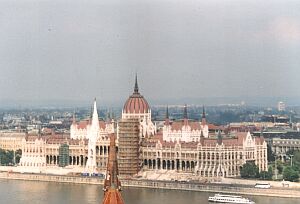
| | |
The large Hungarian Parliament
| |
From Castle Hill in general and Fishermen's Bastion in particular, visitors can enjoy a picture-perfect view of
the Országház (Parliament building). One thing is for sure - no expenses were
spared to erect this bulky complex. The neo-Gothic structure was built under the supervision of Imre Steindl between 1884 and
1902. Obviously, the building resembles the Parliament in London. The large dome in the middle of the Parliament has
got exactly the same height as St Stephen's Basilica - 96 metres. The Parliament is facing the Danube river and is exactly
265 metres long. Inside the building, there are some 700, more or less richly decorated rooms. All in all, 40 kilogram of pure gold
was used. Since the Parliament is really large, it requires a lot of maintenance. This means that reconstruction work will
never finish - once they are done, they can start from the beginning again.
On October 23 in 1989, the stairway of the Parliament became the stage for the proclamation of the 'Democratic Republic of Hungary'.
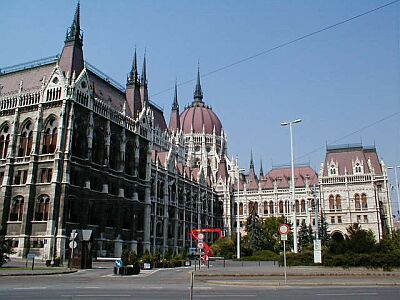
| |
Side view of the Parliament
|
The building is still used by the Hungarian Parliament and as the prime minister's residence.
The royal insignia of St Stephen, the founder of the First Hungarian Empire, are kept inside the building.
Provided that the Hungarian parliament is not debating, it's possible to join a group and see the
Parliament from inside. Groups start two times a day only, admission fee is 900 Ft.
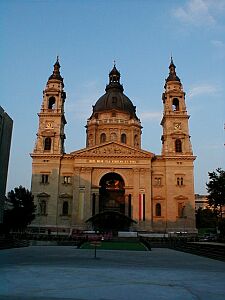
| |
St. Stephen's Basilica
|
A few hundred metres south of the Parliament and close to the central Deák Tér,
the above-mentioned 96 metres high Szent István Bazilika (St Stephen's Basilica)
dominates the view. The large church has enough seats for 8,000 visitors and is built in the neo-Renaissance style.
Construction work started in the year 1851, but somehow the project was ill starred from the very beginning.
The first architect József Hild started to build the church in the classicist style. Unfortunately, he died
after a few years. To make things worse, the huge dome collapsed in 1868. The next architect, Miklós Ybl,
continued the construction in the neo-Renaissance style as well, but he died before it could be completed, too. And so
another architect, József Hauser, had to complete the cathedral.
It's even possible to climb the dome - there's an observation platform on the top of it, providing a fine view over the roofs
of Pest and more.
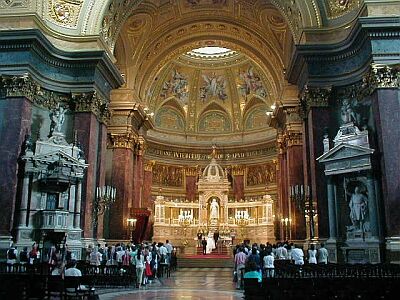
| |
Inside St Stephen's Cathedral
|
The real dimension is only getting clear when you step inside. The main dome has a diameter of 22 metres,
and the fact that it's 96 metres high makes it even more impressive. Of course, the entire church is richly
decorated.
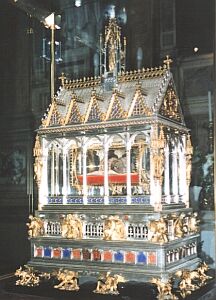
| |
The holy Right inside the Basilica
|
Inside the Basilica next to the altar stands a precious reliquary. It contains the mummified hand of
St Stephen's - as already mentioned above, he was the founder of the First Hungarian Empire in the year 1000.
The relic itself is simply referred to as the Holy Right. Quite clever: To see the hand
visitors must throw in a coin so that the light goes on. That reminds me on a small waterfall in Germany where
you have to pull a rope so that the water flows. Thank you for flushing the toilet! Year by year there's a
large procession ending inside the Basilica dedicated to St Stephen.
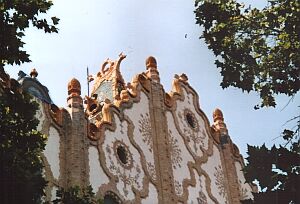
| |
The National Bank of Hungary
|
When you walk back from St Stephen's Basilica to the Parliament, you will soon find Szabadság Square
and the well-secured American embassy nearby. Around that area, there are many extravagant buildings. Among them is
the Hungarian National Bank. The building was created in the beautiful Art Noveau style
and completed around the year 1900. The details of the building are very impressive. Yes, I love art noveau.

| |
Buildings around Szabadság Square are worth a closer look
|
Most of the buildings in the district between Parliament and Basilica were built around the year 1900.
Gates, windows and doors let the visitor be impressed by beautiful ornaments. This area is worth an extensive
walk.
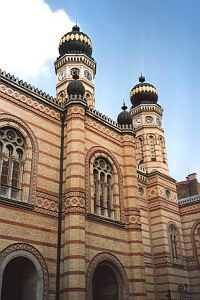
| | |
The Budapest Synagogue
| |
Some hundred metres south-east of central Deák Square stands the
Zsinagóga (Synagogue). Thanks to its distinctive colour and the architecture
it's impossible to miss the building. The synagogue was completed in the year 1859. Behind the building
starts the former Jewish ghetto. Starting in medieval times there was a large Jewish community living in Budapest.
Things changed dramatically in 1944, when the fascist Arrow Cross movement took over (see also
→History of Hungary).
It marked the beginning of two terrible years for the Budapest diaspora, since Hungary started to hand over hundred thousands of Jews to Nazi Germany
or they killed them in Hungary. Somehow, the twin-towered synagogue survived. Today it's nothing less then Europe's largest active
synagogue. There's a museum about the history of Hungarian Jews attached to the synagogue.
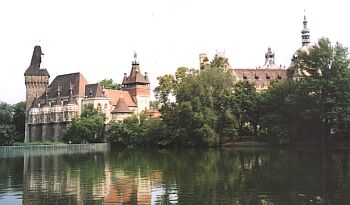
| |
Castle inside the City Park
|
North-east of the centre and a bit away from everything lies the large Városliget (City Park).
This park is around 1 km² big and contains a large lake, lots of green, a zoo (with cages built in the Art nouveau style!)
and the so-called Vajdahunyad vára, which is some sort of fantasy castle built in 1896.
Parts of the castle resemble the typical structure of a Transylvanian castle - at that time, Transylvania was still a
part of the Austro-Hungarian monarchy. The entire complex shows all architectural styles used within the
Hungarian empire some 100 years ago - altogether more than 20 different styles! Today it houses the Agricultural Museum.
The castle is something like an architectural disneyland. The whole park is very nice, and it's easy to spend a full day inside without getting bored.
The huge square in front of the City Park is called Hősök Tere - Heroe's Square. The square and the surrounding
structures were built in 1896. The same year as the castle...what a coincidence. Not really, because Budapest hosted the World Exhibition in 1896.
For the same reason, the subway line connecting the square with the city centre was completed - this makes it Europe's oldest subway line.
The Heroe's square is dedicated to the 1000th anniversary of the arrival of Magyar tribes in the Danube basin.
Of course there's plenty more to see in Budapest. But Budapest is a large and busy city, so seeing it all in one session can
be very stressful.
|
|
|
|
|
|
|
There's also much to see in the vicinity. Which doesn't come as a surprise, since Budapest lies in the heart of Hungary, and
Hungary is not very big. Besides Budapest, the most famous place in Hungary is definitely the Balaton-tó (Lake Balaton).
Due to the lack of a real coastline, the lake is sometimes referred to as the Hungarian Sea. The lake starts around 90 km south-west of
Budapest and stretches 77 km to the west. The lake is long, but the distance between the southern and northern shore is very
short, and so the water surface is 600 km² only. It's still enough to make it the biggest European lake outside Scandinavia.
The Balaton is very popular with Hungarian and international visitors, because it's mostly extremely shallow (at some points, it's even
possible to walk from one shore to the other) and therefore the water temperature is quite high in summer. Especially the towns lining up along the
hilly northern shore are interesting -worth mentioning are the towns of Keszthely, Balatonfüred
and Tihany, a tiny town occupying Tihany peninsula. The area is dotted with pensions, hotels and campsites, so it's definitely
no problem to find a place to stay. The Balaton region is also famous for its wine production. Lake Balaton is easily accessible
from Budapest by bus and train.
On the way to Lake Balaton, a short stopover in Székesfehérvár is no waste of time.
The place is also known by its German name "Stuhlweissenburg". The small town has a picturesque centre. It played a very important
role in the →History of Hungary.
A few kilometres north of Budapest, the so-called Dunakanyar (Danube bend) marks another interesting area of the
country. There, historic towns like →Szentendre, Viségrad,
→Esztergom and Vác line up along the river. All of them are worth a visit
and can be seen in a day trip.
Another interesting town which is not too far for a day trip is →Győr west of Budapest.
East of Budapest, the famous Puszta, part of the Great Plain, starts.
|
|
|
|
|
|
|
The large and confusing variety of accommodation in Budapest can be confusing. During the last decade, hundreds of new hotels,
hostels and pensions mushroomed all over the place. From dirt cheap to breathtakingly expensive - everything is possible.
Touts for hostels and hotels loiter in and around the train stations welcoming newly arrived travelers. Common sense should be
practiced. Another option for visitors without hotel reservation is to head for the tourist information. There are some branches inside
the major train stations as well.
One of the numerous hostels is called Diáksport Hostel. It's a rather large hostel and quite far away from
the city centre. But it's still conveniently located, because it's only two stations away from Nyugati pu. (take the blue line to the north).
The rooms are tiny and so are the bunk beds - it makes you feel like being in a children's room. Additionally, it's a noisy place.
Travelers looking for a quiet and spacious room should look for an alternative. A double costs 3,700 Ft a night.
Anyway, the bar in the basement, open 24 hrs, is a meritorious feature of Diaksport Hostel.
Address: XIII Dózsa György út 152 (the relevant subway station has the same name).
Tel.: 340 8585, Fax: 320 8425.
|
|
|
|
|
|
|
www.budapest.com
The official web portal of Budapest with tons of links and plenty of information. English.
www.budapestinfo.hu/en
English version of the Tourist Office of Budapest website. Quite useful, too.
www.budpocketguide.com
Online edition of the Budapest Pocket Guide - another useful source of information in English.
www.budabab.com
Website of BudaBab - a small Bed and Breakfast on the Pest side. The website offers plenty of
information, too. English.
Do you have or do you know a good website about Budapest? Don't hesitate, let me know!
After checking it, I would love to add it to the link list.
Please note that commercial websites will be declined. For e-mail link see menu on the left.
|
|
| |